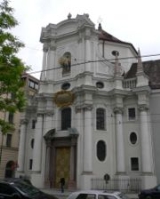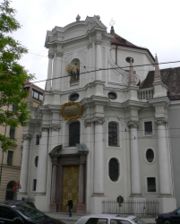
Giovanni Antonio Viscardi
Encyclopedia
Giovanni Antonio Viscardi (* 27 December 1645 in San Vittore, Grisons; † 9 September 1713 in Munich
) was a Swiss architect of the baroque
, who worked mostly in Bavaria
.
 Giovanni Antonio Viscardi descended from a family which provided several architects who had worked in Bavaria, Styria and Mainz
Giovanni Antonio Viscardi descended from a family which provided several architects who had worked in Bavaria, Styria and Mainz
. He started his career as a Superintendent to Enrico Zuccalli
before 1675; in 1678 he was appointed master mason and in 1685 chief architect. Dismissed in 1689 Viscardi worked as an independent architect until he became Zuccalli's successor as chief architect of the Bavarian court in 1706 with the Austrian occupation of Bavaria; he died in office.)
Munich
Munich The city's motto is "" . Before 2006, it was "Weltstadt mit Herz" . Its native name, , is derived from the Old High German Munichen, meaning "by the monks' place". The city's name derives from the monks of the Benedictine order who founded the city; hence the monk depicted on the city's coat...
) was a Swiss architect of the baroque
Baroque
The Baroque is a period and the style that used exaggerated motion and clear, easily interpreted detail to produce drama, tension, exuberance, and grandeur in sculpture, painting, literature, dance, and music...
, who worked mostly in Bavaria
Bavaria
Bavaria, formally the Free State of Bavaria is a state of Germany, located in the southeast of Germany. With an area of , it is the largest state by area, forming almost 20% of the total land area of Germany...
.

Mainz
Mainz under the Holy Roman Empire, and previously was a Roman fort city which commanded the west bank of the Rhine and formed part of the northernmost frontier of the Roman Empire...
. He started his career as a Superintendent to Enrico Zuccalli
Enrico Zuccalli
Enrico Zuccalli, was a Swiss architect who worked for the Wittelsbach regents of Bavaria and Cologne....
before 1675; in 1678 he was appointed master mason and in 1685 chief architect. Dismissed in 1689 Viscardi worked as an independent architect until he became Zuccalli's successor as chief architect of the Bavarian court in 1706 with the Austrian occupation of Bavaria; he died in office.)
Chief works
- Mariahilfkirche at Freystadt Abbey (1700–08)
- New church of St. Mary of Fürstenfeld AbbeyFürstenfeld AbbeyFürstenfeld Abbey is a former Cistercian monastery in Fürstenfeldbruck in Bavaria, Germany.It is situated about 25 km north-west of Munich. The abbey was one of the household monasteries of the Wittelsbachs...
(1701-?) (completed in 1747).) - Schäftlarn AbbeySchäftlarn AbbeySchäftlarn Abbey is a Benedictine monastery on the Isar in Schäftlarn, south of Munich in Bavaria, Germany.-History:The monastery was founded in 762 by Waltrich, a Benedictine monk of noble family, on his own land...
- Expansion of Benediktbeuern AbbeyBenediktbeuern AbbeyBenediktbeuern Abbey is a monastery of the Salesians of Don Bosco, originally a monastery of the Benedictine Order, in Benediktbeuern in Bavaria, near the Kochelsee, 64 km south-south-west of Munich...
- Expansion of the Palace of NymphenburgNymphenburg PalaceThe Nymphenburg Palace , i.e. "Nymph's Castle", is a Baroque palace in Munich, Bavaria, southern Germany. The palace was the main summer residence of the rulers of Bavaria.-History:...
(1702 - ) - BürgersaalBürgersaalkirche (Munich)The Bürgersaal is a historical building in Munich, Germany. Also known as Bürgersaalkirche since the consecration of the altar on May 13, 1778, it is the prayer and meeting room of the Marian Men Congregation "Annunciation". It was built in 1709/1710 under design by Giovanni Antonio Viscardi...
in Munich (1709/1710) - DreifaltigkeitskircheTrinity Church (Munich)The Trinity Church is a religious building in Munich, southern Germany. It is a votive church and was designed in Bavarian Baroque style according to plans from Giovanni Antonio Viscardi from 1711 to 1718. It is a monastery church of the Carmelites and a church of the Metropolitan parish of Our...
in Munich (1711–1714).)

